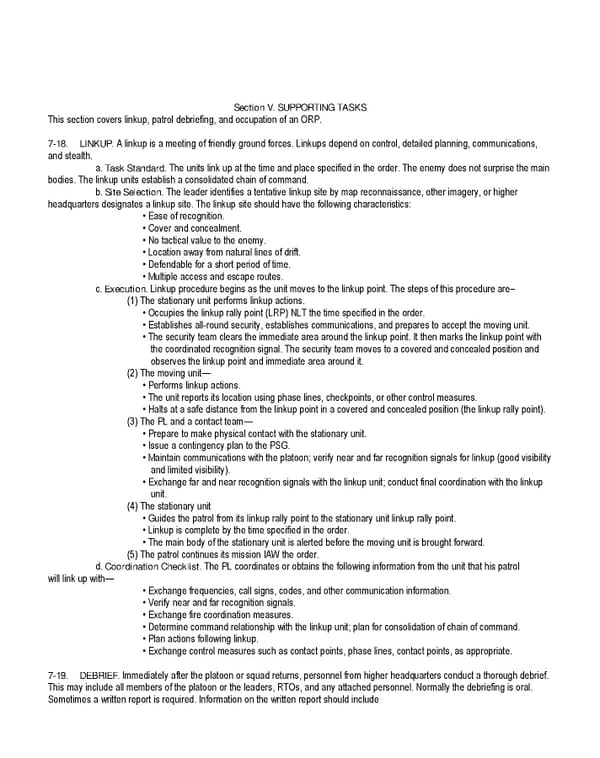Section V. SUPPORTING TASKS This section covers linkup, patrol debriefing, and occupation of an ORP. 7-18. LINKUP. A linkup is a meeting of friendly ground forces. Linkups depend on control, detailed planning, communications, and stealth. a. Task Standard. The units link up at the time and place specified in the order. The enemy does not surprise the main bodies. The linkup units establish a consolidated chain of command. b. Site Selection. The leader identifies a tentative linkup site by map reconnaissance, other imagery, or higher headquarters designates a linkup site. The linkup site should have the following characteristics: • Ease of recognition. • Cover and concealment. • No tactical value to the enemy. • Location away from natural lines of drift. • Defendable for a short period of time. • Multiple access and escape routes. c. Execution. Linkup procedure begins as the unit moves to the linkup point. The steps of this procedure are– (1) The stationary unit performs linkup actions. • Occupies the linkup rally point (LRP) NLT the time specified in the order. • Establishes all-round security, establishes communications, and prepares to accept the moving unit. • The security team clears the immediate area around the linkup point. It then marks the linkup point with the coordinated recognition signal. The security team moves to a covered and concealed position and observes the linkup point and immediate area around it. (2) The moving unit— • Performs linkup actions. • The unit reports its location using phase lines, checkpoints, or other control measures. • Halts at a safe distance from the linkup point in a covered and concealed position (the linkup rally point). (3) The PL and a contact team— • Prepare to make physical contact with the stationary unit. • Issue a contingency plan to the PSG. • Maintain communications with the platoon; verify near and far recognition signals for linkup (good visibility and limited visibility). • Exchange far and near recognition signals with the linkup unit; conduct final coordination with the linkup unit. (4) The stationary unit • Guides the patrol from its linkup rally point to the stationary unit linkup rally point. • Linkup is complete by the time specified in the order. • The main body of the stationary unit is alerted before the moving unit is brought forward. (5) The patrol continues its mission IAW the order. d. Coordination Checklist. The PL coordinates or obtains the following information from the unit that his patrol will link up with— • Exchange frequencies, call signs, codes, and other communication information. • Verify near and far recognition signals. • Exchange fire coordination measures. • Determine command relationship with the linkup unit; plan for consolidation of chain of command. • Plan actions following linkup. • Exchange control measures such as contact points, phase lines, contact points, as appropriate. 7-19. DEBRIEF. Immediately after the platoon or squad returns, personnel from higher headquarters conduct a thorough debrief. This may include all members of the platoon or the leaders, RTOs, and any attached personnel. Normally the debriefing is oral. Sometimes a written report is required. Information on the written report should include
 Ranger Handbook Page 129 Page 131
Ranger Handbook Page 129 Page 131